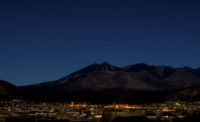Program: Near Anza Borrego Desert State Park, Richard Orne designed a single-family residence for himself and his designer wife, Susan Hancock, in one of only two “dark sky” communities—areas designated to minimize light pollution and preserve the natural darkness of night skies—in the U.S.
Location: Indian Head Ranch, Borrego Springs, California
Solution: The house is perched on a gentle slope, where the flat desert floor begins rising toward the Santa Rosa Mountains, just 10 miles to the east. The structure’s linear, elongated layout and floor-to-ceiling glazing aims to maximize contact with the outdoors and views of the dramatic landscape. Living room, dining room, and kitchen open to one another at the center of the house, with bedrooms and bathrooms at either end.
Construction and materials: The rigid steel frame structure falls somewhere between pre-manufactured assembly and conventional custom construction. Elevated for minimal site impact and maximum water flow, the house has a double roof for enhanced heat deflection with a 6kW photovoltaic array. Ceiling cassette mini-splits allow for heating and cooling in only the occupied areas of the home, which is clad in double-insulated low-e glass and cement fiberglass panels with a rainscreen application. Susan Hancock designed all interior colors and finishes, and cork panel flooring is used throughout.
Additional Information
Completion date: January 2015
Total project cost: Withheld
Client: Richard Orne and Susan Hancock
PeopleArchitect:
Richard Orne and Susan Hancock
Engineers:
Strucktur Studio
General contractor: ASUL
Photographer: Judy Parker, Terry Doyle, Richard Orne
Consultants:
Landscape: Susan Hancock |
ProductsStructural System Steel Moment Resisting Frame, TGI Wood Floor and Roof Joists
Exterior Cladding Metal panels: Roof Metal/glass curtain wall: Double Insulated Units w/ Low E Glass Rainscreen: Cement Fiberglass panels on exterior walls with rainscreen application
Roofing
Built-up roofing: Double roof Metal: Exposed Steel Structure
Windows Wood frame: Custom Steel Windows and Glazing with Structural Silicone Joints Metal frame: Custom Steel Detailing at Glass Walls
Glazing
Glass: Custom Steel Windows and Glazing with Structural Silicone Joints
Doors Entrances: Full Height, Fully Insulated, Metal doors to exterior decks Metal doors: Full Height Metal Doors at interior Sliding doors: Custom Full Height sliding, surface mounted doors at Bathrooms
Hardware Locksets: Baldwin, Oiled Bronze Closers: Every Interior door
Interior Finishes Cabinetwork and custom woodwork: IKEA Solid surfacing: Ceaserstone counters Floor and wall tile: Cork Panel Flooring throughout, ceramic tile in Bathrooms, Laundry and Kitchen Raised flooring: All colors and finishes designed by Susan Hancock Special interior finishes unique to this project: All colors and finishes designed by Susan Hancock
Energy Energy management or building automation system: HVAC system is a series of ceiling cassette mini-splits permitting the house to be heated or cooled in only the areas that are occupied. Photovoltaic system: 6KV System on Roof with inverters located in Garage Other unique products that contribute to sustainability: All materials were selected for durability within a highly impactful environment. All materials were also selected for their recyclability including plastic lumber composite exterior decking. Add any additional building components or special equipment that made a significant contribution to this project: The steel frame and its minimal need for foundations made the shell construction efficient and acheiveable within this remote desert setting
|









Post a comment to this article
Report Abusive Comment